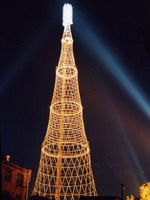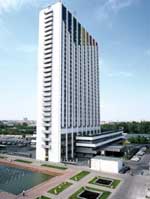 |
| source: photostranger.com |
When the Eiffel Tower was built in Paris, as an example of engineering development in architecture, the Russian engineer and architect Vladimir Shukhov has invented a quite new way to construct high structures, which later influenced on the development of world architecture in general. One of the brightest examples of his method was the broadcasting tower, built in Moscow, on the street of Shabolovka. Later it was called the Shabolovka tower, or the Shukhov Tower.
The story of the tower construction begins in 1919, when Shukhov worked out the project of lattice tower with the height of 350 meters. However, due to the lack of funding because of the civil war, the project has been redesigned, and the construction of 148 meter-high-tower began on March 14, 1920. It was finished in two years and began to broadcast on March 19, 1922, from the highest point of Moscow at that time. Later, after the installation of two cross-arms and a flagpole, the Shukhov tower reached a height of 160 meters.
The uniqueness of the construction consisted in the horizontal circular sections, connected by straight steel beams placed at an angle to the vertical tower, creating a hyperbolic rotation. This technique reminds the rob twisting, which create additional strength. However, the twisting was around the horizontal rings and it helped to achieve the vertical stability. The invention was ingeniously simple.
Due to the easiness and strength this tower gained the world recognition. Moreover, Shukhov used this model much earlier: the first hyperboloid tower he built in the city of Nizhny Novgorod for the Arts and Industrial Exhibition in 1896. He also used this principle of construction in the creation of water towers, masts of ships, and various pillars. But after the construction of Shukhov Tower, this technique began to be used all over the world: such towers were built in Japan, Czechia, Switzerland and other countries. In 2005-2009, the 610-meter-high lattice Shukhov-tower was constructed in China. But the more important fact is that Shukhov's ideas influenced on many architects of our time: the most famous one is Norman Foster, the English architect, who builds skyscrapers around the world.
Today, the Shukhov Tower is recognized as one of the greatest achievements of engineering in architecture. However, almost 90 years after construction, it needs a restoration, because it has never been restored yet. The main problem is corrosion, which gradually has destroyed the structure. But experts perceive the attempts to strengthen the tower by welded elements as barbarism and violation of the basic design ideas.
The tower is not accessible for tourists, and the issue of restoration and the creation of appropriate tourism infrastructure, which will allow the public access to the tower, is under process Let's wait and look at it from a distance.







